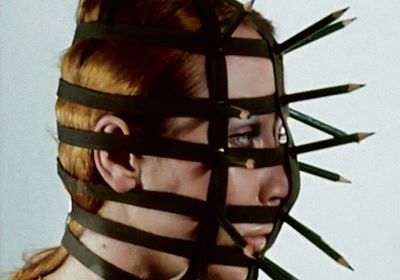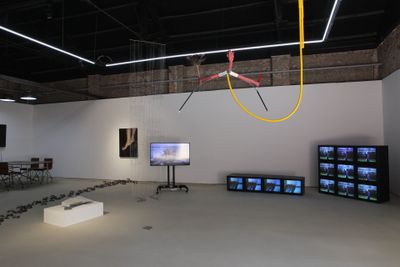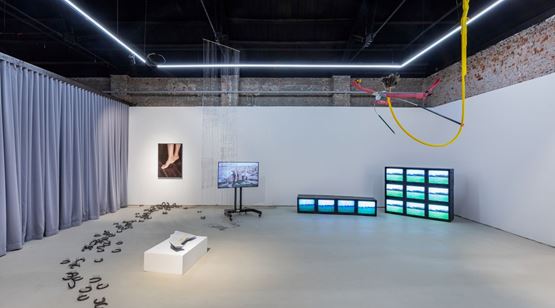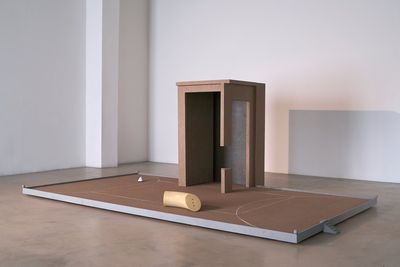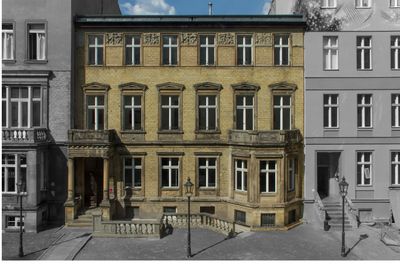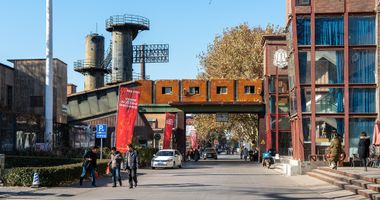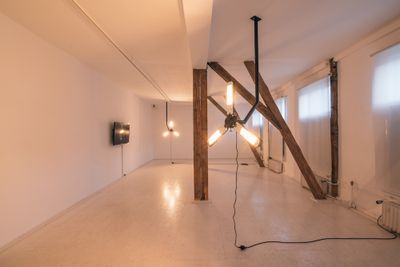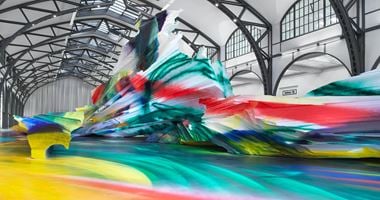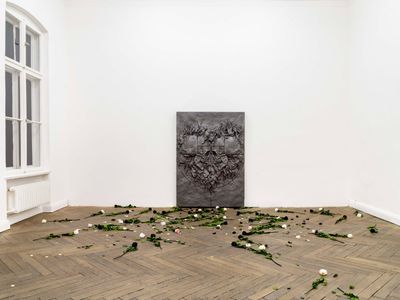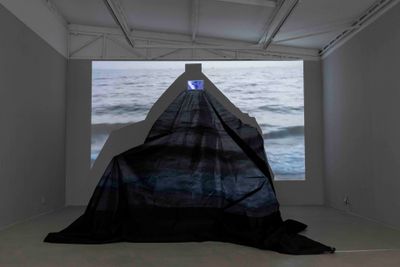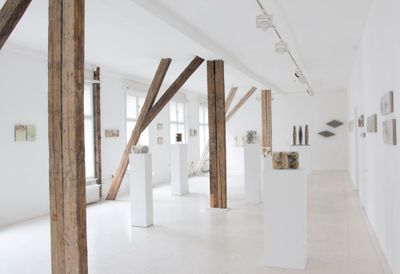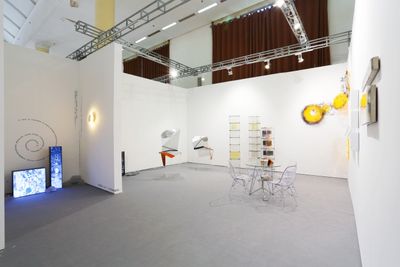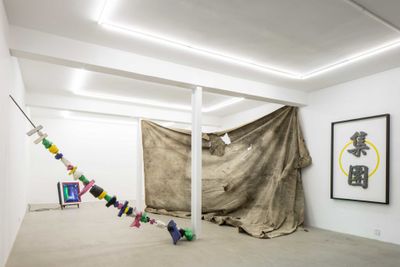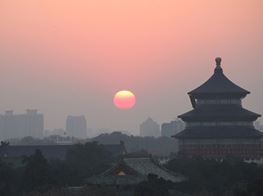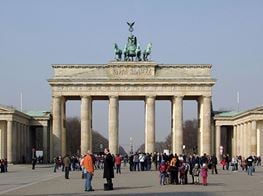Hua Xiaochan: Being International
Hua International | Sponsored Content
Hua Xiaochan. Courtesy Hua International.
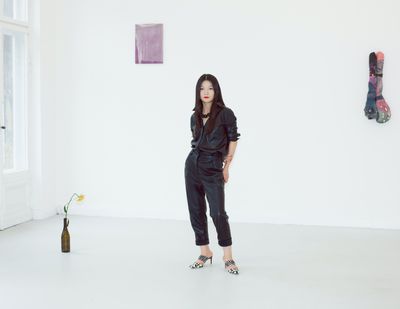
Hua Xiaochan. Courtesy Hua International.
In 2017, Hua Xiaochan and her husband Klaus Dierkes founded Hua International—formerly known as XC.HuA Gallery—with a Berlin space located in the former press offices of the German daily newspaper, Der Tagesspiegel. That same year, the gallery established a branch in Beijing's Caochangdi art district before relocating to 798 Art District in 2020, a move that marks a new chapter in the gallery's trajectory.
Hua International's inaugural exhibition in the 798 Art District showcases an ethos balancing local practice with international exchange. Touching Feeling (29 August–25 October 2020) considers how sensations, memories, and personal histories might adopt physical form in the work of six artists: Rebecca Horn, Chen Dandizi, Fanny Gicquel, Tong Kunniao, Stella Zhong, and Zhang Yibei. Departing from Rebecca Horn's seminal video works, Performance I (1972) and Performance II (1973), which bring together film documentation of performances in which props, including worn sculptural forms, intervene on the body, Touching Feeling also responds to the current pandemic through its consideration of shifting perspectives around the notion of touch.
Across both spaces, the gallery often invites curators to organise exhibitions. Justin Polera, founder of the Berlin-based non-profit institution PS120, curated the recent exhibition Walking in Ice (23 July–19 August 2020) in Berlin along with curator Li Beike. The show explored the 'delicate and dynamic entanglements between the self and the other' in the works of Leda Bourgogne, Zuzanna Czebatul, Fanny Gicquel, Nona Inescu, Julian-Jakob Kneer, Ariane Müller & Martin Ebner, Alvaro Urbano, and Tobias Spichtig. Li Beike also curated Meditation Station in Beijing (29 June–11 August 2020), which took Magnetic Rose, Katsuhiro Otomo's 1995 animated film about astronauts collecting waste, a way to frame the multimedia works of Yu Jing, Jiang Zhuyun, Andrew Sunderland, Egami Etsu, and Charlotte Piene.
More recently, curator Li Boyan organised The Glowing Warmth (23 March–30 April) 2020 in Beijing, which takes a quote by Hegel describing history as a pile of ashes with a temperature to frame a re-evaluation of art's relationship with the social. Zhang Jiaxing, for instance, creates lightbox assemblages made from the detritus sourced from their surroundings in Yanjiao in central Hebei province, from neon lights to TV screens and wooden windows. Aside from staging considered and ambitious group exhibitions, the gallery also focuses on single artists. In 2019, the established curator Yang Zi curated Wu Wei's solo exhibition The Gigantic (26 April–15 June 2019), which showcased minimalist works composed with the construction of a Chinese character in mind, with a trio of 'radicals' expressed through material, form, and symbolic function.
Having bases in both Berlin and Beijing does not come without challenges, of course. With that in mind, Ocula speaks with Hua International's founder and art director, Hua Xiaochan, about the development of the gallery's global identity through exhibition curation, gallery management, and the establishment of an artist roster.
PLCould you talk a little bit about the first exhibition at the gallery's new Beijing space, Touching Feeling?
HXThe exhibition was inspired by a book of the same name by Eve Kosofsky Sedgwick, a scholar in queer studies, which explores the body's expression of feelings through touch. With the pandemic having endured for more than half a year, we believe that people have developed a new understanding of touch. My own desire for touch has become stronger than ever. Choosing such a theme for our first exhibition in Beijing is our manner of responding to the current situation, which I hope will make people re-examine the way we communicate with each other through touch.
PLThe exhibition includes both established and emerging artists, such as Stella Zhong, who is currently completing her MFA in Sculpture at Yale University. What were the criteria for selecting artists for this exhibition?
HXThis exhibition brings together six artists from different regions. Starting with Rebecca Horn, who was born in 1944, the exhibition generates a dialogue across time and space between Horn and the other five younger artists, who were born after the 1990s. Among all German contemporary artists, Horn has always been a personal favourite of mine. Functioning as a kind of index to the exhibition, her iconic body art videos, Performance I (1972) and Performance II (1973), raise questions around the physical expression of feelings. The younger artists' works challenge these questions through work that has been newly commissioned for this exhibition.
Among these artists, Fanny Gicquel, Tong Kunniao, and Chen Dandizi are represented by our gallery. Their artistic practices speak to the gallery's orientations and goals, and I'm looking forward to working with them in the coming years. Zhang Yibei is an artist we recently came across—she has a lot of ideas and her work fits well with the concept of the exhibition. Our aim is curate our programme in a flexible, contingent, and open way.
You mentioned Stella Zhong, who is studying her MFA in Sculpture at Yale University. She is a witty and eccentric young genius with interesting ideas. Through her sculptural interventions, Stella interprets her unique observations of the non-human environment. Before joining Yale, Stella had already gained some attention in New York though a number of cutting-edge exhibitions and projects.
Working with more mature or experienced artists may be an effective way to avoid risks, but that might also result in new discoveries being missed along the way. I prefer discovering emerging artists for that reason, as I find it exciting and motivating to grow together with my artists. That experience of 'picking the star' is very distinctive.
Developing a global vision is one of my primary tasks as a gallery owner, and it's something I'm constantly working on. Just a week before the pandemic started to spread around the world, I was moving around New York, going to exhibitions and art fairs, meeting artists and collectors. During the pandemic, I made over 50 one-on-one online studio visits via web conferencing, trying to keep as much direct contact with artists as possible. It is important to keep updating one's knowledge, and to combine it with direct observation in order to make your own clear judgment.
PLHua International was established within one of Berlin's gallery clusters in 2017, and three years later, the Beijing outpost was established in the city's core art district. While the relocation suggests your ambition to compete with the big galleries, what was the intent behind the location of the spaces and the decision to have outposts in both places? How will you allocate your time in the future? And could you also talk about the future programming of both spaces?
HXIn terms of the location, you could say we were lucky to have spaces with great geographic advantages. In early March 2020, we decided to move to 798 Art District as the pandemic caused access restrictions to Caochangdi, prompting the decision to bring forward the move, which was originally scheduled for 2021. It was a timely decision.
Just like human beings, a gallery can carry out art projects and exhibitions with a strong personality, but how they are received is completely out of our control.
There is no connection between the relocation and the desire to compete with larger galleries. Defining a gallery in terms of the size of its space is vague and inaccurate. In Berlin, a lot of great galleries are hidden in smaller spaces in the city, and they represent some of the best artists in the world, and come up with thoughtful, cutting-edge exhibitions. Though they might have about 150 square metres or less, they remain active at the forefront of the contemporary art scene. Some spaces may only be as big as the front of a gallery in China. The key competency of a gallery lies in its artist list and the quality of its exhibitions, not in the size of its space.
The decision to set up spaces in two cities was part of our plan since the beginning, as a global platform. While it may be more challenging for me and my team, we still believe it's not only a viable mode, but one that has the potential to grow the gallery further. I am constantly struggling with a balancing process as to how to allocate my time, not only because of the geographic distance and six-hour time difference between Berlin and Beijing, but also as a result of the different contexts, cultures, environments, art markets, and ways of working in the two places. In the future, I expect to manage my time in an efficient, compact, and reasonable way, which requires close coordination within our diverse team. Next year's programme has been mostly decided so far—we plan to do four solo exhibitions and a group project in each space per year.
PLWhat connects the group show Touching Feeling with the gallery's past exhibitions?
HXThis year, our exhibitions are diversified in terms of expression and concept, from A Year Without The Southern Sun (22 February–30 May 2020) at the beginning of the year, to Walking in Ice (24 July–20 August 2020), which just ended in Berlin, to the upcoming Touching Feeling and Tong Kun's solo exhibition Just Stay in the Cold, which will open during Berlin Art Week 2020 in September.
We hope that every exhibition at Hua International will manifest our own unique character. A gallery is similar to a person with a complex character. Exhibitions represent an interrogation of ourselves, along with the comprehensive display of an exhibition concept, the specific qualities of the space, and the characteristics of the artists.
PLWhat are your plans and goals for Hua International?
HXOur current plan is to bring the Berlin team back to Beijing once the pandemic is over, and to have peking duck with our newly established team in Beijing. Our goal is to be recognised as one of the major pioneering international galleries.
PLHua International has a very distinct aesthetic. How would you describe it?
HXAs I said, the gallery should have a complex personality, combining different elements and different forms of expression. Instead of describing the aesthetic of the gallery myself, I'd rather hear the audience's voice. Just like human beings, a gallery can carry out art projects and exhibitions with a strong personality, but how they are received is completely out of our control. This brings us back to the key question of this exhibition: how to touch feeling.
PLWhat prompted you to open your own gallery? What are the current challenges you are facing? I understand you were previously positioned as art director at Matthias Küper Galleries—how did this experience help?
HXThe decision to open a gallery was intuitive but well planned, based on my existing experience working with other galleries. The current challenge is to notice, select, and define the right artists for Hua International, so as to gradually refine our artist list. Another current challenge is to actively make decisions and face various problems during the pandemic.
Good artists and works will naturally attract the attention of institutions and collectors.
The years working at Matthias Küper Galleries polished my ability to run a gallery on my own, owing to the relative freedom that an international gallery allows. I was also able to connect with domestic and international collectors and to grow more incisive on artists and exhibitions.
PLYou were only 30 when you launched the gallery. Do you find your age an advantage for you to gain a better understanding of the work of younger artists?
HXRunning a gallery requires total dedication and energy, and being young may keep you from getting exhausted. But when it comes to making key decisions for a gallery, I don't really think age is a crucial advantage. As we have talked about previously, the development of a global vision, the ability to make judgments about art, and having knowledge of art practice or theories might be more important than age in helping artists to understand their work.
PLIn what ways has the gallery progressed over the years, apart from its growing competitiveness in terms of its locations?
HXThe geographical advantage is only secondary. The gallery is still in its early stages, when clear direction and orientation should become its backbone, and this is mainly reflected in the selection of artists. I think our most significant achievement so far has been the increasing clarity of both the gallery's direction and the criteria for selecting artists.
PLCan you describe how your criteria or the way you work with artists has changed in recent years?
HXThe gallery has been in operation for three years, and its early history is very different from many other galleries, as we simultaneously landed in Beijing and Berlin. The distance is unlike that between London and Paris, and beyond the six-hour time difference, the challenge lies in the difference between the markets, contexts, cultures, and regions of the two galleries.
The decision behind the gallery's location makes me think of my three-year-old son, who has been exposed to different languages and cultures since birth. It might have taken him longer than other children to learn to speak, but he will eventually adapt to having three mother tongues. Similarly, Hua International has developed from this hybrid, multi-regional culture. Although we have to face a potentially more extensive preparation period, we hope that in the long term, we will be able to naturally adapt to multicultural environments, and thus be able to provide artists with a global platform more easily. We seek to grow together with our artists under the influence of our unique genes.
As for the selection of artists, we expect to see their self-reflection present in their works, and to demonstrate a clear plan for their future practices. It is a two-way selection and collaboration, and we have always been open to all kinds of experimentation and experiences. It is only through this process that we will realise whether or not we can reach a common understanding with our artists.
PLHow do you work with artists, and how do you maintain relationships with artists, collectors, and institutions?
HXEach artist is a luminous entity with different talents and personalities. I like to keep close contact with the artists I work with, sharing the gallery's daily activities and work details with them, and exchanging ideas and plans every now and then. I prefer to work in an open, transparent, and direct manner, which avoids unnecessary disagreements and makes it easier to build mutual trust and understanding. Meanwhile, the relationship between us and collectors or institutions is based on the quality of the gallery. Good artists and works will naturally attract the attention of institutions and collectors.
PLCan you talk about what fascinates you in the work of the young Chinese artists that you work with?
HXThe young Chinese artists I work with convey a universal value in their work. Although they may be labelled as 'Chinese' or 'young', the key concepts or presentation of their work brings a strong feeling of de-identification. Their ways of expression are diverse, of course. For example, Stella Zhong, who was born in China but has studied in the United States since a very young age, demonstrates a strong personal style in her work rather than being confined to any specific region. Chen Dandizi has created works with a strong feminine tone, but with a central concern for human emotions. Another artist worthy of attention is Tong Kunniao, who is participating in the exhibition Touching Feeling. During Gallery Weekend Berlin, we will present Tong's solo exhibition, Where to Where, after more than one year of preparation.
Influenced by the specific social environment in China, Tong's work also explores issues of globalisation, such as the understanding of individual identity in the face of consumerism, and the vitality of such concepts and works is not limited by labels of geography or generation. There are many artists who I have not mentioned, but whose humanistic concerns and trans-contextual concepts, coupled with their mature practice, endows their work with the potential to be perceived in a more pluralistic context, which is absolutely fascinating.
PLWith a distinctive exhibition programme in Berlin and Beijing consisting of many young artists, how would you describe your collectors? Do you try to educate young new collectors?
HXOur group of collectors is still quite diverse, although many of them are young. One thing about the young collectors is that they all have a profound knowledge of contemporary art and have been exposed to many excellent major exhibitions around the world, which cultivates their good taste and judgment in art. Although some new collectors may have just started collecting art, their knowledge and understanding of contemporary art is very surprising.
In front of these young collectors, the gallery can hardly be said to be an educator. I hope to manage the gallery with my experience and keen judgment, and then let the collectors make their own judgments and choices. This allows for an exchange of tastes, rather than a simple instruction from one to the other. I also believe that mutual trust based on taste and quality can create a virtuous cycle from gallery to collector and vice versa.
PLYoung curators are often invited to organise group exhibitions at Hua International, which makes the programming very refreshing. How do you collaborate with the curators? Do these curated exhibitions benefit sales?
HXI want to be open to making different attempts and experimentations, and that is why we launched the annual curatorial project in the gallery's two spaces, in addition to the exhibitions we organise independently. We want to provide a platform for young curators, and in the meantime, create an opportunity to exchange ideas.
For this annual curatorial project, I would like the collaboration to be simple and pure, in which everyone is doing their job, to put it simply. While the gallery has a professional team to do all the routine work from publicity to sales, the curator is expected to bring in an experimental proposal with good content based on the direction and personality of our gallery, which is implemented in collaboration with the gallery team. Within such a structure, we do not necessarily relate the curator to sales. The sales, from both the curatorial project and the independent gallery exhibitions, should be the result of the quality of the exhibitions.—[O]


